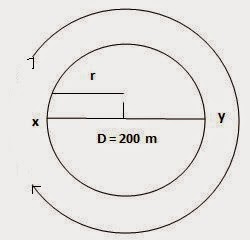NCERT Solution: Motion
Final speed of the train, v = 0 (finally the train comes to rest)
Acceleration = - 0.5 m s-2
According to third equation of motion:
v2= u2+ 2 as
(0)2= (25)2+ 2 ( -0.5) s
Where, s is the distance covered by the train
The train will cover a distance of 625 m before it comes to rest.
Initial Velocity of trolley, u= 0 cms-1
Acceleration, a= 2 cm s-2
Time, t= 3 s
We know that final velocity, v= u + at = 0 + 2 x 3 cms-1
Therefore, The velocity of train after 3 seconds = 6 cms-1
Initial Velocity of the car, u=0 ms-1
Acceleration, a= 4 m s-2
Time, t= 10 s
We know Distance, s= ut + (1/2)at2
Therefore, Distance covered by car in 10 second= 0 × 10 + (1/2) × 4 × 102
= 0 + (1/2) × 4× 10 × 10 m
= (1/2)× 400 m
= 200 m
Initially, velocity of the stone,u= 5 m/s
Final velocity, v= 0 (since the stone comes to rest when it reaches its maximum height)
Acceleration of the stone, a= acceleration due to gravity, g = 10 m/s2
(in downward direction)
There will be a change in the sign of acceleration because the stone is being thrown upwards.
Acceleration, a = - 10 m/s2
Let s be the maximum height attained by the stone in time t.
According to the first equation of motion:
v= u + at
0 = 5 + ( - 10)t
t= -5 / -10 = 0.5 s
According to the third equation of motion:
v2 = u2+ 2as
(0)2= (5)2+ 2( - 10) s
s= 52 / 20 =1.25 m
Hence, the stone attains a height of 1.25 m in 0.5 s.
Radius of circular track (r) = 200 / 2=100 m
Time taken by the athlete for one round (t) = 40 s
Distance covered by athlete in one round (s) = 2π r
= 2 � ( 22 / 7 ) � 100
Speed of the athlete (v) = Distance / Time
= (2 � 2200) / (7 � 40)
= 4400 / 7 � 40
Therefore, Distance covered in 140 s = Speed (s) � Time(t)
= 4400 / (7 � 40) � (2 � 60 + 20)
= 4400 / (7 � 40) � 140
= 4400 � 140 /7 � 40
= 2200 m
Number of round in 40 s =1 round
Number of round in 140 s =140/40
=3 1/2
After taking start from position X,the athlete will be at postion Y after 3 1/2 rounds as shown in figure

Hence, Displacement of the athlete with respect to initial position at x= xy
= Diameter of circular track
= 200 m
Total Distance covered from AB = 300 m
Total time taken = 2 × 60 + 30 s
=150 s
Therefore, Average Speed from AB = Total Distance / Total Time
=300 / 150 m s-1
=2 m s-1
Therefore, Velocity from AB =Displacement AB / Time = 300 / 150 m s-1
=2 m s-1
Total Distance covered from AC =AB + BC
=300 + 200 m
Total time taken from A to C = Time taken for AB + Time taken for BC
= (2 × 60+30)+60 s
= 210 s
Therefore, Average Speed from AC = Total Distance /Total Time
= 400 /210 m s-1
= 1.904 m s-1
Displacement (S) from A to C = AB - BC
= 300-100 m
= 200 m
Time (t) taken for displacement from AC = 210 s
Therefore, Velocity from AC = Displacement (s) / Time(t)
= 200 / 210 m s-1
= 0.952 m s-1
The distance Abdul commutes while driving from Home to School = S
Let us assume time taken by Abdul to commutes this distance = t1
Distance Abdul commutes while driving from School to Home = S
Let us assume time taken by Abdul to commutes this distance = t2
Average speed from home to school v1av = 20 km h-1
Average speed from school to home v2av = 30 km h-1
Also we know Time taken form Home to School t1 =S / v1av
Similarly Time taken form School to Home t2 =S/v2av
Total distance from home to school and backward = 2 S
Total time taken from home to school and backward (T) = S/20+ S/30
Therefore, Average speed (Vav) for covering total distance (2S) = Total Distance/Total Time
= 2S / (S/20 +S/30)
= 2S / [(30S+20S)/600]
= 1200S / 50S
= 24 kmh-1
Given Initial velocity of motorboat, u = 0
Acceleration of motorboat, a = 3.0 m s-2
Time under consideration, t = 8.0 s
We know that Distance, s = ut + (1/2)at2
Therefore, The distance travel by motorboat = 0 ×8 + (1/2)3.0 × 82
= (1/2) × 3 × 8 × 8 m
= 96 m